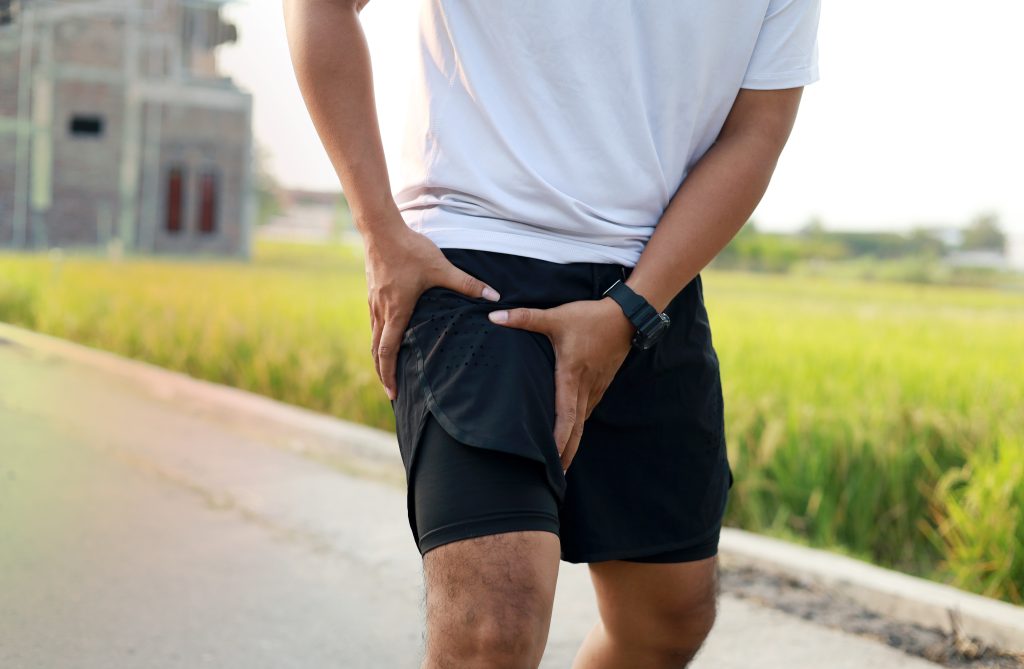Feeling a sudden, sharp pain at the front of your hip might be a clear sign that something has happened to your hip flexor muscles. Hip flexor tears are a common injury among athletes, fitness enthusiasts, and individuals with active lifestyles. Whether you’ve pulled your hip flexor during a workout or you’re experiencing this hip pain for seemingly no reason, understanding the symptoms and treatment options is key to a full recovery.
Hip flexor tear symptoms
The hip flexor muscles connect the front of your hip to your thigh and are engaged when you lift your knee up toward your chest. Hip flexor injuries vary from minor strains to serious tears; from mild discomfort to significant pain. Here are the key symptoms to look out for if you suspect an issue:
- Sharp or sudden hip pain – Many people report a sharp, stabbing pain in the front of the hip or groin area. This often occurs during activities that engage the hip flexors, such as running, kicking, or jumping.
- Muscle weakness – A hip flexor tear can make it difficult to lift your leg or perform movements involving the hip flexor muscles. You may notice weakness during everyday actions, like climbing stairs.
- Tenderness and swelling – The affected area may feel tender to the touch and could show signs of swelling or bruising. This is the body’s response to the injury as it initiates the healing process.
- Reduced mobility – An injured hip flexor often reduces your range of motion, making it uncomfortable or impossible to fully extend or flex your hip.
- Popping sensation – Some individuals report feeling or hearing a popping sensation at the moment of injury, which could indicate a torn muscle or ligament.
In some cases, mild injuries can be healed with rest and time. However, if you keep pushing through with your normal routine or workouts, a minor strain can develop into a more severe injury, prolonging recovery time.
Possible causes for hip pain
While pulling a hip flexor is a common cause of hip pain, it’s important to note that other conditions may also lead to similar symptoms. Understanding the exact cause of your pain is the best way to get truly effective treatment.
- Hip bursitis – This condition occurs when the bursae (fluid-filled sacs that cushion your hip joints) become inflamed. Hip bursitis often causes pain on the outside of the hip.
- Labral tears – A labral tear affects the cartilage along the rim of your hip joint socket. This can create a catching or clicking sensation in your hip, along with persistent pain.
- Arthritis – Osteoarthritis or rheumatoid arthritis can cause stiffness, pain, and inflammation in the hip joint over time, especially in older adults.
- Iliopsoas tendinitis – Inflammation of the iliopsoas tendon can result in pain in the front of the hip, similar to a hip flexor tear.
Because there’s such a wide variety of potential causes for hip pain, seeing a professional physical therapist for an evaluation is strongly recommended to ensure you get effective treatment rather than simply hoping the pain goes away on its own.
Treating a hip flexor tear or strain
At-home remedies
It’s not uncommon for people who experience a sudden hip pain to simply take it easy for a few days to see if it gets better. Common self-care treatments that can help the body heal while continuing your routine include:
- Rest
- Activity reduction
- Over-the-counter medication
- Ice and heat
- Elevating the leg/hip
While a lot of these options don’t cost you anything, there’s no guarantee you’ll feel better in a few days or weeks. And for more serious hip flexor injuries, avoiding treatment may make the problem worse over time.
Recovering from muscle strains can be complex, because too much rest or immobilization can lead to stiffness and muscle weakness. Over-the-counter medication can help you get through a few hours of discomfort, but isn’t something that should be relied on every single day. Finally, there may be a completely different issue involved than what you’ve discovered from your own research. For all these reasons, it’s strongly recommended to see a physical therapist when your lifestyle gets disrupted by sharp pain in your hip.
Physical therapy
Physical therapy is frequently recommended as the first line of treatment for a hip flexor tear or strain. It’s a conservative option that works to strengthen the muscle and improve function without invasive procedures. If you’re unsure about your injury’s severity, starting with physical therapy is a safe and effective choice.
A physical therapist will give you professional guidance based on a complete evaluation of your symptoms and health history. They also may have multiple options for treatment to meet your specific needs.
Although your progress may not be immediate, it can be long-lasting with the right injury prevention plan for your specific activity level. At Armor Physical Therapy, we have specialists in all kinds of sports and recreational activities, including performing arts, to give you the professional advice you need to stay injury-free for longer.
Advanced treatments
For severe cases, options like corticosteroid injections or, in rare instances, surgery may be recommended as the most effective treatment for a hip flexor tear. If these advanced treatments are the best way forward, your doctor will give you all the information you need for making the right choice for your health.
Hip pain treatments at Armor Physical Therapy
Don’t wait for your pain to go away on its own if it’s interrupting your lifestyle. PT is accessible, often more affordable than other medical interventions, and the first step in any long-term approach to healing.
Armor has clinics throughout southwest Michigan, including in Kalamazoo, St. Joseph, and Holland. Call a nearby clinic directly or request an appointment online today to get started.

